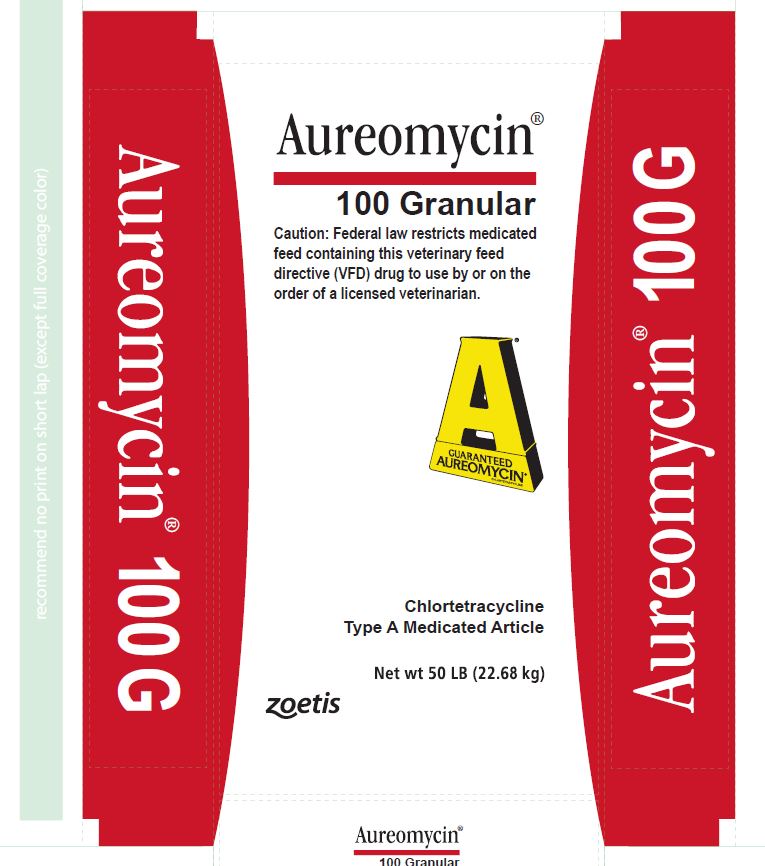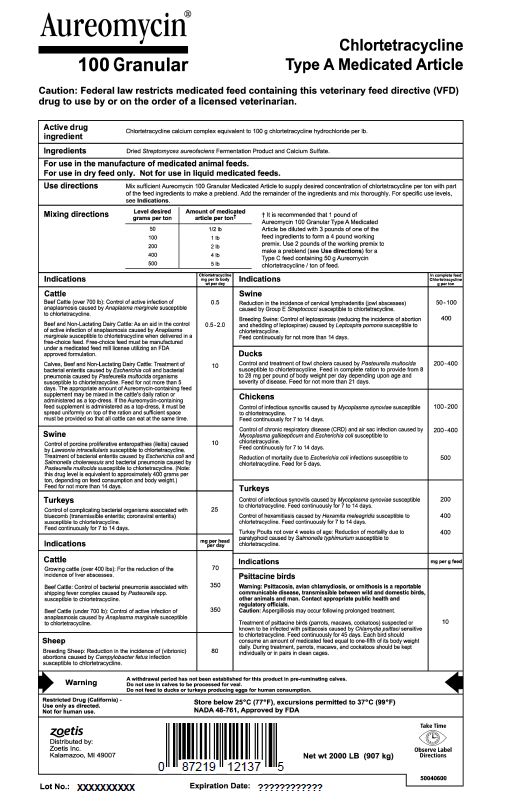AUREOMYCIN- chlortetracycline hydrochloride granule
AUREOMYCIN by
Drug Labeling and Warnings
AUREOMYCIN by is a Animal medication manufactured, distributed, or labeled by Zoetis Inc.. Drug facts, warnings, and ingredients follow.
Drug Details [pdf]
- SPL UNCLASSIFIED SECTION
- Active drug ingredient
- Ingredients
- PURPOSE
-
Use directions
Mix sufficient Aureomycin 100 Granular Medicated Article to supply desired concentration of chlortetracycline per ton with part of the feed ingredients to make a preblend. Add the remainder of the ingredients and mix thoroughly. For specific use levels, see Indications.
-
Mixing directions
Level desired
grams per tonAmount of medicated
article per ton*50
1/2 lb
100
1 lb
200
2 lb
400
4 lb
500
5 lb
† It is recommended that 1 pound of Aureomycin 100 Granular Type A Medicated
Article be diluted with 3 pounds of one of the
feed ingredients to form a 4 pound working
premix. Use 2 pounds of the working premix to
make a preblend (see Use directions) for a
Type C feed containing 50 g Aureomycin
chlortetracycline / ton of feed.
-
Indications
Indications Chlortetracycline
mg per lb body
wt per dayCattle Beef Cattle (over 700 lb): Control of active infection of anaplasmosis caused by Anaplasma marginale susceptible to chlortetracycline. 0.5 Beef and Non-Lactating Dairy Cattle: As an aid in control of active infection of anaplasmosis caused by Anaplasma marginale susceptible to chlortetracycline when delivered in a free-choice feed. Free-choice feed must be manufactured under a medicated feed mill license utilizing an FDA approved formulation. 0.5-2.0 Calves, Beef and Non-Lactating Dairy Cattle: Treatment of bacterial enteritis caused by Escherichia coli and bacterial pneumonia caused by Pasteurella multocida organisms susceptible to chlortetracycline. Feed for not more than 5 days. The appropriate amount of Aureomycin-containing feed supplement may be mixed in the cattle's daily ration or administered as a top-dress. If the Aureomycin-containing feed supplement is administered as a top-dress, it must be spread uniformly on top of the ration and sufficient space must be provided so that all cattle can eat at the same time. 10 Swine Control of porcine proliferative enteropathies (ileitis) caused by Lawsonia intracellularis susceptible to chlortetracycline.
Treatment of bacterial enteritis caused by Escherichia coli and Salmonella choleraesuis and bacterial pneumonia caused by Pasteurella multocida susceptible to chlortetracycline. (Note: this drug level is equivalent to approximately 400 grams per ton, depending on feed consumption and body weight.)
Feed for not more than 14 days.10 Turkeys Control of complicating bacterial organisms associated with bluecomb (transmissible enteritis; coronaviral enteritis) susceptible to chlortetracycline. Feed continuously for 7 to 14 days. 25 Indications mg per head
per dayCattle Growing Cattle (over 400 lb): For the reduction of the incidence of liver abscesses. 70 Beef Cattle: Control of bacterial pneumonia associated with shipping fever complex caused by Pasteurella spp. susceptible to chlortetracycline. 350 Beef Cattle (under 700 lb): Control of active infection of anaplasmosis caused by Anaplasma marginale susceptible to chlortetracycline. 350 Sheep Breeding Sheep: Reduction in the incidence of (vibrionic) abortions caused by Campylobacter fetus infection susceptible to chlortetracycline. 80 Indications In complete feed
Chlortetracycline
g per tonSwine Reduction in the incidence of cervical lymphadenitis (jowl abscesses) caused by Group E Streptococci susceptible to chlortetracycline. 50-100 Breeding Swine: Control of leptospirosis (reducing the incidence of abortion and shedding of leptospirae) caused by Leptospira pomona susceptible to chlortetracycline. Feed continuously for not more than 14 days. 400 Ducks Control and treatment of fowl cholera caused by Pasteurella multocida susceptible to chlortetracycline. Feed in complete ration to provide from 8 to 28 mg per pound of body weight per day depending upon age and severity of disease. Feed for not more than 21 days. 200-400 Chickens Control of infectious synovitis caused by Mycoplasma synoviae susceptible to chlortetracycline.
Feed continuously for 7 to 14 days.100-200 Control of chronic respiratory disease (CRD) and air sac infection caused by Mycoplasma gallisepticum and Escherichia coli susceptible to chlortetracycline.
Feed continuously for 7 to 14 days.200-400 Reduction of mortality due to Escherichia coli infections susceptible to chlortetracycline. Feed for 5 days. 500 Turkeys Control of infectious synovitis caused by Mycoplasma synoviae susceptible to chlortetracycline. Feed continuously for 7 to 14 days. 200 Control of hexamitiasis caused by Hexamita meleagridis susceptible to chlortetracycline. Feed continuously for 7 to 14 days. 400 Turkey Poults not over 4 weeks of age: Reduction of mortality due to paratyphoid caused by Salmonella typhimurium susceptible to chlortetracycline. 400 Indications mg per g feed Psittacine birds Warning: Psittacosis, avian chlamydiosis, or ornithosis is a reportable communicable disease, transmissible between wild and domestic birds, other animals and man. Contact appropriate public health and regulatory officials. Caution: Aspergilliosis may occur following prolonged treatment. Treatment of psittacine birds (parrots, macaws, cockatoos) suspected or known to be infected with psittacosis caused by Chlamydia psittaci sensitive to chlortetracycline. Feed continuously for 45 days. Each bird should consume an amount of medicated feed equal to one-fifth of its body weight daily. During treatment, parrots, macaws, and cockatoos should be kept individually or in pairs in clean cages. 10 - Warning
- Storage
- SPL UNCLASSIFIED SECTION
- PRINCIPAL DISPLAY PANEL - 50 LB Bag
- PRINCIPAL DISPLAY PANEL - 2000 LB Supersack
-
INGREDIENTS AND APPEARANCE
AUREOMYCIN
chlortetracycline hydrochloride granuleProduct Information Product Type VFD TYPE A MEDICATED ARTICLE ANIMAL DRUG Item Code (Source) NDC: 54771-1003 Route of Administration ORAL Active Ingredient/Active Moiety Ingredient Name Basis of Strength Strength CHLORTETRACYCLINE HYDROCHLORIDE (UNII: O1GX33ON8R) (CHLORTETRACYCLINE - UNII:WCK1KIQ23Q) CHLORTETRACYCLINE HYDROCHLORIDE 100 g in 0.45 kg Product Characteristics Color GRAY (gray/brown) Score Shape Size Flavor Imprint Code Contains Packaging # Item Code Package Description Marketing Start Date Marketing End Date 1 NDC: 54771-1003-1 22.68 kg in 1 BAG 2 NDC: 54771-1003-2 907 kg in 1 SUPERSACK Marketing Information Marketing Category Application Number or Monograph Citation Marketing Start Date Marketing End Date NADA NADA048761 01/01/2009 Labeler - Zoetis Inc. (828851555)
Trademark Results [AUREOMYCIN]
Mark Image Registration | Serial | Company Trademark Application Date |
|---|---|
 AUREOMYCIN 71691736 0639933 Live/Registered |
AMERICAN CYANAMID COMPANY 1955-07-22 |
© 2025 FDA.report
This site is not affiliated with or endorsed by the FDA.

